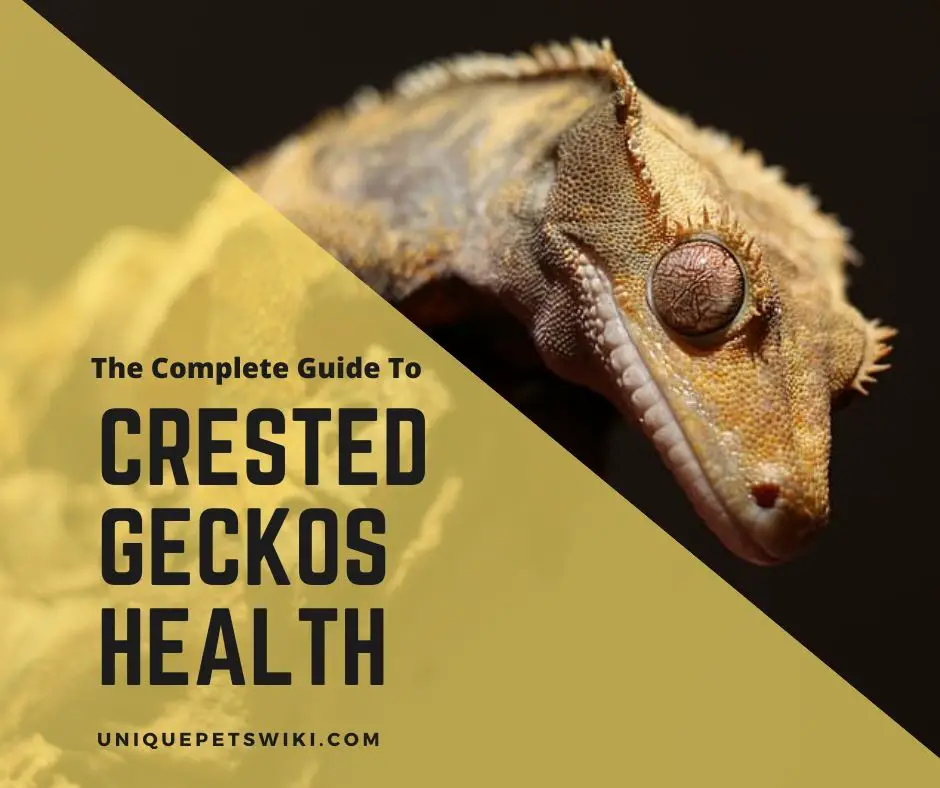Crested geckos are among the best reptiles to keep at home for beginner pet owners. Crested geckos are quite hardy and easy to care for. You can keep your crested gecko health at an optimal level by providing proper care at all times.
You can easily prevent them from getting sick by regular checks, weighing, optimal farming, and monitoring them. This article will get more insight into the different gecko diseases and illnesses, symptoms, prevention, and treatment.
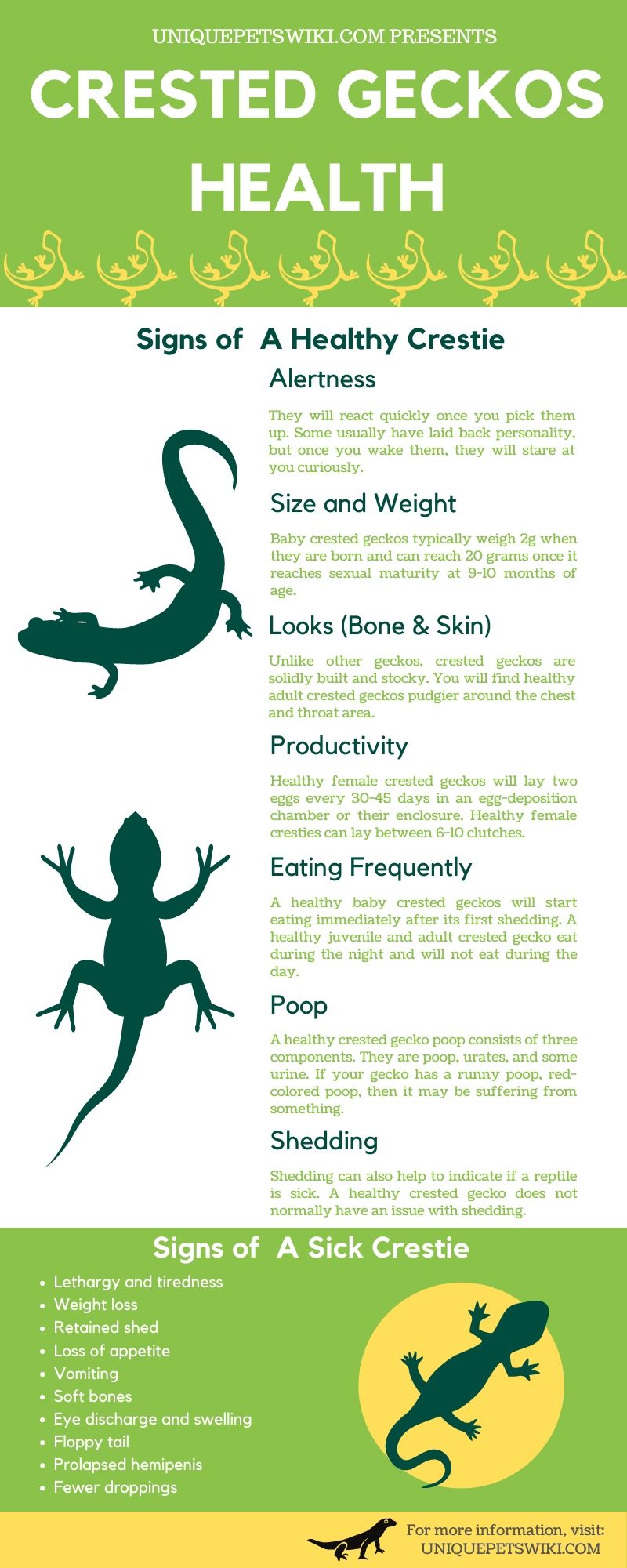
Contents
- Signs Of A Healthy Crested Gecko
- Signs of a Sick Crested Gecko
- Crested Gecko Shedding Problems
- Crested Gecko Eating Problems
- Crested Gecko Pooping Problems?
- Impaction and Constipation in Crested Geckos
- Tail Dropping In Crested Geckos
- MBD In Crested Geckos
- Eye Problems and Infections in Crested Geckos
- Stress In Crested Geckos
- Crested Gecko Sexing Problems
- Crested Gecko Mating Problems
- Prolapse of Hemipenes in Male Crested Geckos
- Egg-bound Crested Gecko
- Baby Crested Gecko Problems And Prevention
- Crested Gecko Growing Problems
- Should I Worry When my Cresties Grow Slower than Normal?
- My Crested Gecko Can’t Climb The Glass
- Conclusion
Signs Of A Healthy Crested Gecko
It is easy to maintain crested gecko health if you start with a healthy species. It is best if you buy your crested gecko from breeders with a good reputation. Before you buy your gecko, ensure that you check for signs that indicate good health. Some of the signs to look out for are stated below.
Alertness
Although crested geckos are nocturnal, they will react to you once you pick them up for examination. Some usually have laid back personality, but once you wake them, they will stare at you curiously. However, a sick gecko may tremble or feel unbalanced in your hand.
Size & Weight
A healthy hatchling and baby crested geckos usually grow quickly. Baby crested geckos typically weigh 2g when they are born and can reach 20 grams once it reaches sexual maturity at 9-10 months of age.
Although the weight of crested gecko can be different from each other, adult crested geckos can weigh between 30-55g, and it is suffering from obesity if it weighs over 65g. Adult gecko is underweight if it weighs less than 30g.
Your gecko can become underweight for several reasons like bullying, internal parasites, soft bones, stress, etc. You will find pelvic bones sticking out of skinny crested geckos. They will also be thin around the neck and limbs.
Looks (Bone, Skin)
Unlike other geckos, crested geckos are solidly built and stocky. The hip bones that are around their pelvis area are not protruded. However, you can see ribs in young and adult crested geckos based on the angle you view.
You will find healthy adult crested geckos pudgier around the chest and throat area. If the gecko looks thin, then it may be suffering dehydration rather than diseases or poor diets.
Productivity
Healthy female crested geckos will lay two eggs every 30-45 days in an egg-deposition chamber or their enclosure. The female gecko will dig a hole in the substrate before laying the eggs in it and then cover them up. During the breeding season, healthy female cresties can lay between 6-10 clutches.
Eating Frequently
A healthy baby crested geckos will start eating immediately after its first shedding, which occurs 2-3 days after hatching. A healthy juvenile and adult crested gecko eat during the night and will not eat during the day.
Poop
A healthy crested gecko poop consists of three components. They are poop, urates, and some urine. Urates are considered as the solid form of urine, and it is secreted for minimizing water loss. If your gecko has a runny poop, red-colored poop, then it may be suffering from something.
Shedding
Shedding can also help to indicate if a reptile is sick. Shedding in crested gecko is usually weekly for hatchlings and juvenile while it is about once or twice a month for the adult gecko.
A healthy crested gecko does not normally have an issue with shedding. However, unhealthy crested geckos might have issue shedding, and you may need to help out.
Signs of a Sick Crested Gecko
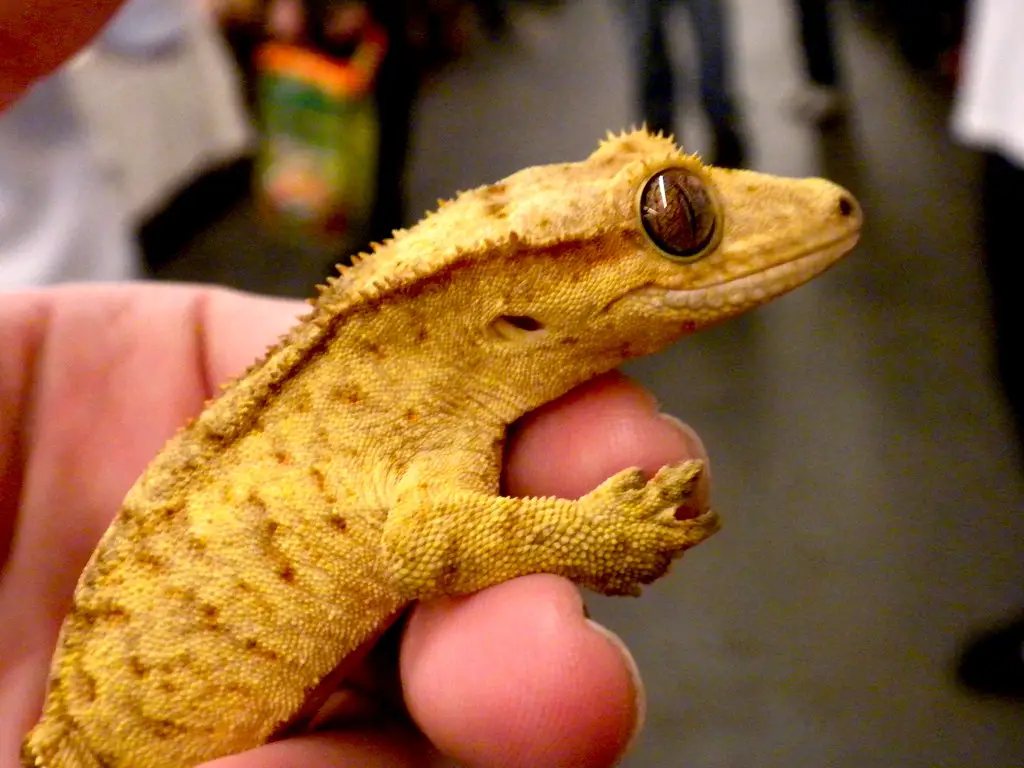
- Lethargy and tiredness
- Weight loss
- Retained shed
- Loss of appetite
- Vomiting
- Soft bones,
- Eye discharge and swelling
- Floppy tail
- Prolapsed hemipenis
- Fewer droppings
Lethargy
A healthy crested gecko is usually active during the night and moves around their tank. Crested gecko will respond to what they see and hear and are usually alert. However, sick crested geckos can stay stationary for hours or even hide in their tank at night.
It may even be too weak to push up off their bellies onto their legs. Sick geckos may slither around like snakes if it tries to move. If you notice these behaviors, it is best to get your animal to the vet immediately.
Fewer Droppings
A healthy crested gecko poop consists of three components. They are poop, urates, and some urine. Urates are considered as the solid form of urine, and it is secreted for minimizing water loss.
If you notice fewer droppings in your crested gecko’s tank, you will need to pay attention to the pet’s appetite. If your gecko has a runny poop, red-colored poop, then it may be suffering from something.
Crested Gecko Shedding Problems
Your crested gecko can have trouble shedding if the humidity levels of their tank are low. Your crested gecko can also have shedding problems if they are sick. A retained shed on geckos can lead to blood flow constriction to the organs and limbs. This can then lead to necrosis or death.
It will take around two days for your gecko to shed and eat the skin. After shedding, you can check out if there is any skin left in their tank. If you find remaining skin, you should remove them.
Always ensure that your crested gecko’s tank has an optimal humidity level. You can even create a hideout with moss for extra humidity.
Stuck Shedding
There are times when crested shedding can go wrong, and you will find stuck skin all over their body, mostly the toes and tails. Stuck sheds can constrict blood flow, leading to the loss of toes, tail tips, or even the entire foot.
If you notice stuck shed, you may need to help your crested geckos out. You can help by putting them in a Tupperware with some lukewarm water and a paper towel. However, ensure that it is not deep to avoid drowning them.
New to crested gecko? Check out the crested gecko care sheet now! We had listed out all the things you need to know about crested gecko as pets. Check it now!
You can leave them in the bath for 20 minutes to see if it helps. After the skin dries out, you can then help them to peel it off. When using this method, ensure that the water is not too hot or warm as your crested gecko are susceptible to heatstroke if exposed to high temperature.
You can put slightly rough accessories in their tank-like rock, branches, and other tank ornaments in their tank to shed on their own. Also, place a water bowl in their tank to provide adequate humidity and water for them to drink when needed.
This is because most times, the shedding problem is as a result of dehydration.
Crested Gecko Eating Problems
It is normal if your crested gecko does not eat for days to a week after introducing it to a new home. Moving to a new home is stressful and leads to eating problems. In this case, all you have to do is minimize handling time and ensure the tank is comfortable.
You may need to force-feed your gecko if they are not eating because of health issues. You may need to feed them with a syringe rich in crested geckos diet.
Crested Gecko Pooping Problems?
A healthy crested gecko should poop a solid piece of poop, urates, and urine while excreting. Your crested geckos can excrete runny poops, which means that you need to feed them with a more rough food diet.
You can then incorporate live or least freeze-dried insects once or twice a week. If your gecko still has the problem after changing diet, then it may be suffering from parasites. Humidity levels and shedding can also cause crested gecko pooping problems.
If your gecko has a runny poop, it should pass within a week, and if not, you might need to take your pet for fecal examination because parasites infect them.
Impaction and Constipation in Crested Geckos
Crested geckos can be impacted if they eat small or large objects that do not digest and get stuck in their intestines. If your gecko swallows the substrates in the tank, it can also be impacted.
Hatchlings and juvenile crested geckos are prone to swallowing substrate as they get to know their environment. It is best if you keep your hatchlings and juveniles on paper towels to avoid impaction.
Some geckos can ingest substrate while feeding. If you notice this, you can feed your gecko with live food in dishes, with feeding tongs, or in a corner with no substrate.
If your gecko still ingests substrates during adulthood, you can use fine substrates that can easily pass when ingested.
Some of the signs of impaction in crested geckos are stated below.
- Loss of appetite
- Your gecko has a plump belly that looks very round
- Rapid weight gain
- Irregular pooping
Tail Dropping In Crested Geckos
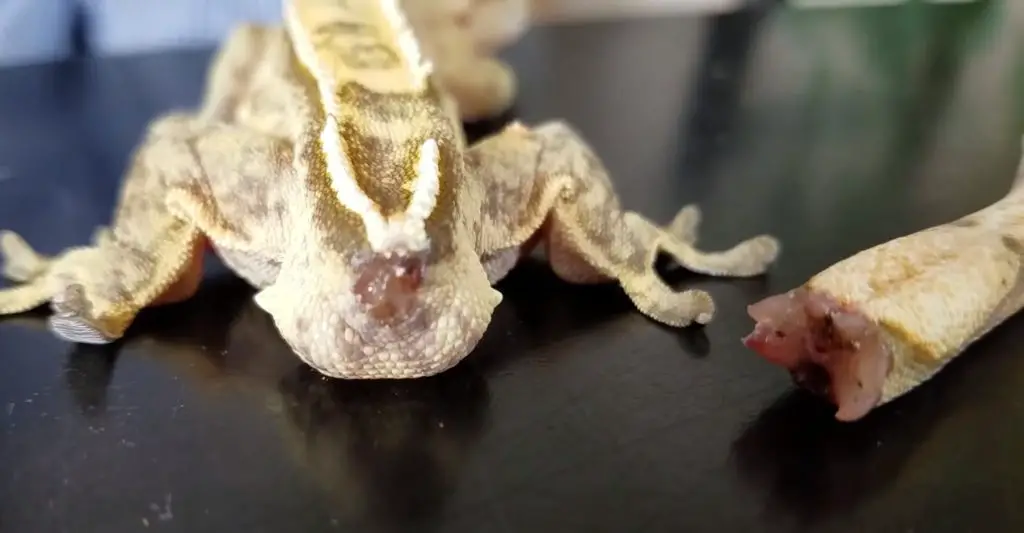
(Source: Clint’s Reptiles YouTube)
Crested gecko can drop its tail very easily. However, the tail does not grow back, but it does not mean that your crested gecko is unhealthy. In the wild many adult crested geckos do not have tails.
It is best to know why crested gecko may drop its tail in captivity to avoid this. Your crested geckos will drop its tail due to several reasons, some of them are stated below.
- Your crested gecko can drop its tail if your rough handle them or pull them by their tail
- Crested geckos may lose its tail if other geckos bully it in its tank
- It may lose its tail if the tail gets stuck.
- Diseases and vitamin deficiencies may also cause tail loss.
- Stressful situations may cause tail loss.
How To Help Your Geckos After They Dropped The Tail?
Once your crested gecko loses its tail, the blood vessels at the tail base will constrict to prevent blood loss. This means your gecko will not lose much blood after dropping its tail.
You can then provide your gecko with a good diet and supplements to help it heal.
You will need to provide a hideout for your gecko in case it wants to hide. You should also clean the tank regularly to avoid the tail base getting infected.
You can even transfer the gecko to a Kritter Keeper until they would dry.
MBD In Crested Geckos
What Is MBD In A Crested Gecko? Symptoms?
Metabolic Bone Disease (MBD) happens when you do not feed your crested geckos with enough calcium or Vitamin B3. It is a prominent disease of young geckos and breeding females. It is common among them because they need higher levels of calcium.
Some of the symptoms of MBD in crested gecko are listed below.
- Weakness and reduced mobility
- Soft jaw
- Loss of appetite
- Kinking of the tail and spine
- Deformed limbs
- Humped back
- Shaking and muscle tremors
- Female crested geckos seem tired and lifeless after laying eggs
- In adult gecko, calcium sacs in the mouth become pale, flat, and almost invisible.
What Causes The MBD In Crested Geckos?
MBD can cause soft bones and bone deformities to your gecko when they cannot metabolize calcium or due to dietary deficiency. MBD in crested gecko can also be caused by the lack of vitamin D3 in their diet.
This is because Vitamin D3 is needed to absorb calcium in crested geckos intestines.
Another thing that can cause MBD is feeding your gecko with a diet rich in phosphorus. This is because too much phosphorus can lead to the removal of calcium in crested gecko’s body.
However, it is hard to notice calcium deficiency from the start, but you will start seeing signs after some months.
How To Prevent MBD and Treat For Your Crested Geckos?
You can easily prevent MBD by providing your crested geckos with a well-balanced diet. It is best to supplement your cresties diet with calcium, Vitamin D3, and other supplements.
Ensure that you gut-load and dust insects with supplements before you give them to your crested gecko. You can only feed your cresties with baby food, purees, and fresh fruits only as a treat. This is because crested geckos can refuse other food after eating fresh fruits.
Female crested geckos can experience calcium crash after laying eggs. You should try to create a cooling period from October to March, where you reduce the amount of light in the day and lower the temperatures.
It will help stop her egg production and help restore her calcium levels while preparing for another breeding season.
Once you notice that your crested gecko has MBD, start feeding them with calcium and vitamin D3 supplementation. You can also take your gecko to the vet for expert advice on how you can treat your crested gecko.
However, mild cases of MBD can be treated, but severe cases might lead to irreversible damage. This is why you need to act immediately as you discover any symptoms related to MBD.
Eye Problems and Infections in Crested Geckos
Crested geckos might have eye infections. The infected eyes can look swollen and bigger because of fluid buildup. If you notice discharge and swelling of your crested gecko’s eye, it may be an eye infection.
It is probably internal eye damage or cataract if your crested gecko’s eye does not swell or discharge fluid. You can use antimicrobial eye drops to treat infections. However, if it does not work or you suspect a cataract, take your gecko to the vet.
Stress In Crested Geckos
Every pet owner wants to keep their pet happy and healthy. But there are times when crested geckos can be scared or stressed because of different reasons.
However, if a crested gecko experiences severe stress for a long time, it can suppress their appetite and immune system. It can even lead to illnesses or death in an extreme case.
Some of the things that can cause crested gecko stress are stated:
- Stress caused by handling
- Stress caused by illness
- Stress caused by firing up
- Stress caused by wrong cage setups
- Stress caused by acclimating
- Stress caused by heat.
Signs Of A Stressful Crested Gecko?
- Aggressive (jumping at the glass)
- Being lethargic and looking sick
- Fast and heavy breathing
- Firing up
- Sudden jump and running away from the owner
- Chirping or growling
- Tail drop
- Sunken eyes or wrinkly skin caused by overheating and dehydration.
- Gaping when the owner approach
- Weight loss
- Arched back to look bigger
Crested Gecko Sexing Problems
You can easily determine the sex of crested gecko once it is around six months old. The hemipenal bulge below the vent can be used to identify the male while the females do not have bulges.
You can also try to identify each sex during the development stage by checking them closely with the jeweler’s loupe. You will recognize the male by the pre-anal pores that run horizontally between their hind legs.
However, females do not have pre-anal pores.
Crested Gecko Mating Problems
Treating of Bites and Wounds During Mating
Male crested geckos can be aggressive against the female when mating. The male will chase the female around the terrarium and subdue them by using its mouth to hold the back of the female neck. The male will bite them in the head several times and can cause bite marks.
Most bite wounds will go away after the female sheds. But there are sometimes when the male bites too hard and leads to an open wound. You will need to remove the female immediately when you notice the open wound.
You can then treat the wound with antibiotics until it has healed. You can then reintroduce the female to the male afterward.
Prolapse of Hemipenes in Male Crested Geckos
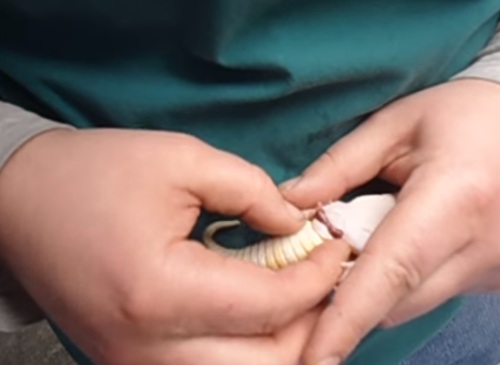
(Source: The Frog Depot YouTube)
Your male crested gecko uses his hemipenes for mating. You will find the hemipenes at the base of its tail. After mating, the hemipenes will go back within an hour, but in some cases, it can take a few hours or even a day. Crested geckos can lick his hemipenes to help it retract.
New to crested gecko? Check out the crested gecko care sheet now! We had listed out all the things you need to know about crested gecko as pets. Check it now!
If the hemipenes does not retract after 5-6 hours, you can place your gecko in a sugar bath. You can make a sugar bath by mixing water with sugar in a container.
You will then place your gecko inside the bath for around 10 minutes. You can repeat this step a few times before the hemipenis retract.
Ensure that there is nothing stuck around the hemipenis that can prevent it from retracting. You can also pour some cold water on the hemipenis for some minutes.
If you have tried these methods and it did not work, you will need to visit the vet as soon as possible to prevent hemipenis necrosis. Your vet will then try to push the hemipenis back in. However, if necrosis of the hemipenis occurs, the vet will need to cut off his hemipenis.
Crested geckos have two hemipenes, and they will breed again.
Egg-bound Crested Gecko
Egg binding is a common health issue for female crested gecko. It is when a female crested gecko cannot pass or lay her egg. This can happen if the egg cannot pass through the gecko’s tube or a gecko cannot find a suitable spot to lay the eggs.
Another reason is when your female crested gecko has a calcium deficiency.
You should note that female crested gecko will start producing eggs from 18-24 months, even without mating. Lots of young female cresties do lay infertile eggs before they started mating with males.
You can detect if your crested gecko is egg-bound by checking and touching her belly. Gravid female crested gecko usually has a wide lower belly, and you will be able to feel the eggs. Ensure you do not apply too much pressure on the gravid female belly to avoid rupturing the eggs.
You can help your female crested gecko feel at home by giving her a warm bath or increasing the temperature of the terrarium to 75 degrees Fahrenheit. However, your female crested gecko will be egg-bound if she cannot lay her eggs.
The eggs will become hard in her belly and get stuck.
You will then need to take egg-bound female crested gecko to the vet. The vet will then surgically remove the eggs from her body or die if untreated.
Baby Crested Gecko Problems And Prevention
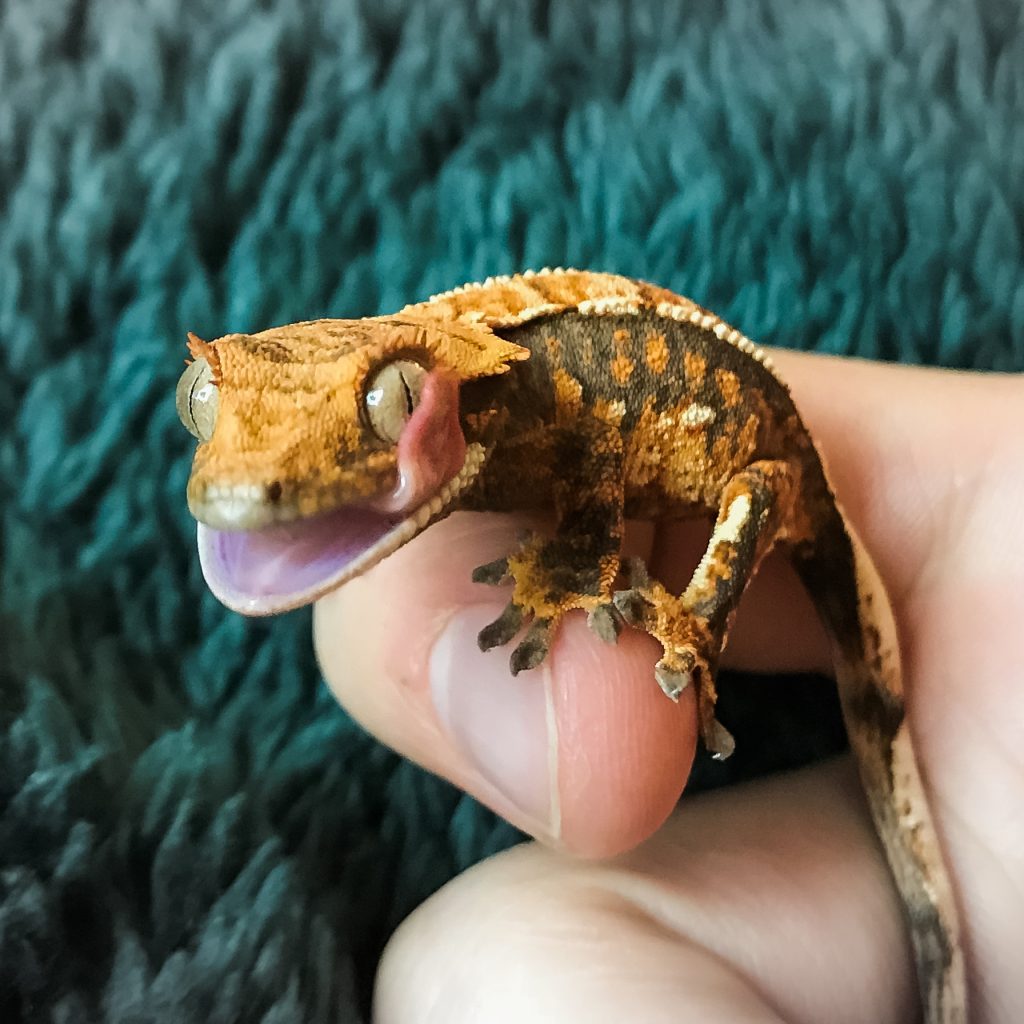
Baby cresties, just like adult crested geckos, are hardy reptiles and easy to care for. However, you will need to be on the lookout for certain things when keeping hatchlings and juveniles.
The major issue with hatchlings is shedding problems. Hatchlings are usually susceptible to stuck shed and dehydration. You will need to make sure that shed skin does not build up around the tails, toes, or limbs.
The buildup of shed skin can constrict blood flow and lead to injury or even amputation. Baby crested geckos shed very often, and shedded skin can build up more quickly.
Baby geckos can easily show signs of nutritional deficiencies if you do not feed them balanced nutrients. It is best to feed them with commercial Crested gecko diets or meal replacement powders.
Some hatchlings can even hatch out with a deficiency if you do not feed their mother properly. You will need to consult with a reptile vet if you suspect Metabolic Bone Disease in your hatchlings.
Crested geckos do not usually have issues, but you can just prepare for the risks involved with the breeding of little geckos.
Crested Gecko Growing Problems
Most crested geckos breeders estimate that it will take 1 to 2 years for a baby gecko to become adults. A healthy gecko needs to gain about 1 gram of weight each month.
Many crested geckos grow in spurs, and there are periods without growth, especially in winter.
However, if your crested gecko is more than a year old and around 8-10g, something might be wrong. Some of the things that can cause growth problems in crested geckos are stated below.
They are Not Eating Enough
Your crested gecko can have slow growth if it is not eating enough. Generally, crested gecko easily gets full. Baby crested geckos are filled up with few licks, while adults can eat about a quarter of a teaspoon.
There are many reasons why your crested gecko is not eating enough.
Low temperature and humidity can cause poor appetite. One of the problems faced by new owners is to set up the optimal heating and humidity for their geckos. This can cause poor appetite for their gecko.
Your gecko may not enjoy what it is eating. There is a wide range of Crested Gecko Diets out there with different consistency and taste. You can try out different food options to determine what your crested gecko likes.
However, you should make sure that you do not feed them with unbalanced baby food or fruits.
The temperature and Humidity of Their Tank are Not at an Optimal Level.
The growth of your gecko can be affected by the temperature in your gecko’s tank. Low temperatures can affect the energy levels, digestion, and immunity of your cresties.
You will need to set your gecko’s terrarium temperature to around 71-79 degrees Fahrenheit, and the cool side should be about 68-70 degrees Fahrenheit.
The suitable humidity level for your crested gecko’s tank is 70%. If it goes down less than 50% for a day, it leads to bacterial and fungal growth. You can try to mist the gecko’s tank before it eats to improve their appetite.
Feeding your Crested Gecko with Incorrect Diet.
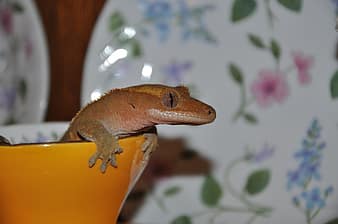
One of the major causes of stunted growth of crested gecko is an incorrect diet. For instance, feeding your crested geckos with baby food and different fruits alone can not only cause slow growth but also cause nutrient imbalance and other diseases.
This is because fruits have a different level of calcium, phosphorus, vitamin, and other minerals.
Feeding your geckos with only fruit can impact calcium absorption. It is best to feed them with fruits and baby foods only as a treat while you feed them with Crested Gecko Diet and Insects.
There Is A Sudden Change In Their Diet
Your crested gecko can start to eat less if you make a sudden change to their diet. If you want fast growth, it is best to feed them with feeder insects once a week. This is because insects provide the extra protein needed for growth.
Feeding crested gecko with only Crested Gecko Diets can cause slower growth. However, you can use crested gecko diets with insects to feed your crested gecko.
Ensure you start feeding your gecko with a crested gecko diet before using fruit as a treat as they can become picky eating.
Your Crested Gecko’s Terrarium Is Too Big
Baby crested geckos grow faster in a smaller enclosure. This is because they will easily find food and water without getting stressed. Ensure you do not house small crested gecko in a big terrarium right away.
You can later move your baby gecko to a big enclosure once they are about 20g. Once they are adults, it is easy to navigate around big terrariums. However, if your terrarium is quite large, you can add two feeding spots for your crested gecko.
Your Crested Gecko Has Parasites
Your crested gecko will grow slowly if it is infected with parasites. This is because parasites can cause an imbalance with nutrient absorption in crested gecko’s digestive system.
Once you get a new crested gecko, try to quarantine it and take its stools to the vet for examinations.
If you notice that your crested gecko has runny poop, sluggish, or other unhealthy signs, you can also take the feces to the vet for an examination.
Your Crested Gecko May Be a Slow Grower
Even with good care, crested geckos will grow at its own rate. Some geckos will grow slower than the others. If you are sure your husbandry is ideal and your cresties are eating properly, you do not have to worry.
However, if your crested gecko is too small for its age, something may be wrong.
Should I Worry When my Cresties Grow Slower than Normal?
You do not have to worry if you are sure that your husbandry is ideal, and your crested geckos are eating properly. But if you notice that your geckos are not eating properly, you can take them to a vet or investigate what causes the problem.
My Crested Gecko Can’t Climb The Glass
The ability of crested gecko to climb glass can be affected by different reasons.
One of the reasons is because it is shedding. It is normal if your crested gecko can’t stick to the glass some days before, during, and after shedding. This is going to pass, but ensure that they do not have retained shed on the toes.
If your crested gecko is sick, it may move less and also climb less. If the glass in their tank is dirty, it can also interfere with sticking. You should make sure that you clean their glass. Another reason is that the surface of their tank may not be suitable for climbing.
Crested geckos love to climb glass and hard surfaces. Your cresties may not be climbing if the tank has low humidity.
Conclusion
Most of the crested gecko health problems can easily be prevented or treated. All you need is to have in-depth knowledge of caring and keeping crested geckos.
